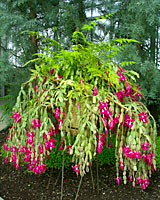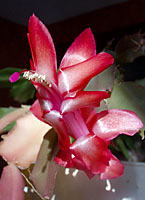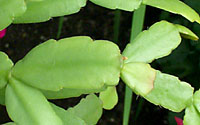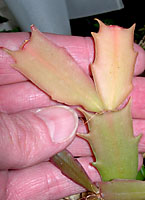Terry L. Ettinger Horticulture Consulting Services
Meeting The Needs Of Today With A Vision For The Future
Question of the Week
Caring for Holiday Cactus
 Q. This past summer I was given custody of a family heirloom - a four foot diameter Christmas cactus that’s been part of our
family since before 1900. I’m intimidated by the responsibility of keeping the plant alive and afraid that I’ve already
messed up because it was in full bloom at least a full week before Thanksgiving! Why did this plant bloom so early and how
do I take care of it in the future?
Q. This past summer I was given custody of a family heirloom - a four foot diameter Christmas cactus that’s been part of our
family since before 1900. I’m intimidated by the responsibility of keeping the plant alive and afraid that I’ve already
messed up because it was in full bloom at least a full week before Thanksgiving! Why did this plant bloom so early and how
do I take care of it in the future?
 A. Though they’re related to desert cacti, the holiday cacti (Thanksgiving and Christmas cactus belong to
the genus Schlumbergera while Easter cactus is in the genus Hatiora) are native to the relatively
cool, mountainous rainforests of southeastern Brazil.
A. Though they’re related to desert cacti, the holiday cacti (Thanksgiving and Christmas cactus belong to
the genus Schlumbergera while Easter cactus is in the genus Hatiora) are native to the relatively
cool, mountainous rainforests of southeastern Brazil.
Holiday cacti are mostly epiphytic, which means they grow on the trunks and branches of trees. Instead of rooting into the ground, they most often root into decaying leaves, bark and bird droppings that accumulate in the crevices and hollows of their host trees.
Taking a cue from their mountainous habitat, holiday cacti thrive when temperatures range from 70ºF-80ºF during the summer down to 50ºF-60ºF from fall through late winter.
It's exposure to cool temperatures, especially at night, that triggers the formation of flower buds. In fact, I’ll bet
the reason your Christmas cactus
 bloomed so early is that it may be growing in a room that's a little on the cool side? The
other possibility is that your Christmas cactus isn't really a Christmas cactus, but rather a hybrid Thanksgiving
cactus which tend to bloom between Halloween and Thanksgiving.
bloomed so early is that it may be growing in a room that's a little on the cool side? The
other possibility is that your Christmas cactus isn't really a Christmas cactus, but rather a hybrid Thanksgiving
cactus which tend to bloom between Halloween and Thanksgiving.
 The way you can tell the two apart is by looking at the edges of their flattened stems, which are called cladodes. The
edges, or margins and Christmas cactus cladodes, above, tend to be
somewhat rounded. Meanwhile, those of Thanksgiving cactus, at left, tend to
be somewhat pointed.
The way you can tell the two apart is by looking at the edges of their flattened stems, which are called cladodes. The
edges, or margins and Christmas cactus cladodes, above, tend to be
somewhat rounded. Meanwhile, those of Thanksgiving cactus, at left, tend to
be somewhat pointed.
A second cue from their native habitat is the importance of a well-drained potting soil that mimics the decaying organic matter in which they grow. Fortunately, peatmoss-based potting soils such Pro-Mix, Jiffy-Mix, and others fit the bill nicely as they hold a lot of water yet drain rapidly.
Speaking of water, keeping holiday cacti moist - but not wet - from March through August will encourage maximum growth. Adding quarter-strength, water-soluble houseplant fertilizer to the water once a month is also a good idea. From September through February, however, water plants only once every two to three weeks to keep the soil just barely moist and don’t fertilize at all.
As I mentioned above, the trick getting your holiday cacti to flower are cool autumn temperatures. If you can keep them in a room that’s between 50ºF-60ºF (but no cooler) at night beginning in September, you’re practically guaranteed of having flowering plants in November - even if you ignore them!
Getting them to set buds is trickier if you keep them in a room where temperatures don’t drop below 60ºF.
In this situation, your cacti won’t set flower buds unless they’re grown in complete darkness for about thirteen hours every day for six weeks. You can do this by keeping your plants in a room that’s brightly lit during the day and completely dark at night. Or, you can move them into a dark room or closet every evening around 5:00, then back to a bright room each morning.
Unfortunately, because of their daylength/temperature sensitivity, it may be impossible to bring holiday cacti into bloom if night temperatures never drop below 70ºF.
Finally, in addition to enjoying the colorful flowers that healthy holiday cacti bear during an otherwise dreary time of year, these plants can provide a lot of satisfaction because they’re so easy to propagate.
Simply twist off stem segments with your thumb and index finger and stick them about one-half inch deep into slightly moist Pro-Mix or Jiffy-Mix at any time of the year - except when the parent plant is in bloom. In three to six weeks the segments will have rooted and within a year, you’ll have a good-sized plant!
Not only is this a great way to insure that your family's legacy will live on should anything happen to the original plant, but you can also share it with members of your family, your friends and neighbors, too!
For More Information:
If you really want to learn more about growing holiday cacti and the characteristics of more than 40 varieties, check out University of Massachusetts researcher Thomas H. Boyle's 1993 study, "Commercial Production of Holiday Cacti."
And, if you want to purchase some of the varieties described in the study above, the most comprehensive source that I've found is Bob Smoley's Gardenworld.